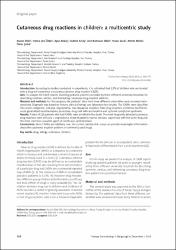Cutaneous drug reactions in children: a multicentric study

Göster/
Erişim
info:eu-repo/semantics/openAccessTarih
2014Yazar
Dilek, NurselÖzkol, Hatice Üçe
Akbaş, Ayşe
Kılınç, Fadime
Dilek, Aziz Ramazan
Saral, Yunus
Metin, Ahmet
Çalka, Ömer
Üst veri
Tüm öğe kaydını gösterKünye
Dilek, N., Ozkol, H.U., Akbas, A., Kilinc, F., Dilek, A.R:, Saral, Y., Metin, A., Calka, O., (2014). Cutaneous drug reactions in children: a multicentric study. Postepy Dermatologii I Alergologii, 31(6), 368-371. https://doi.org/10.5114/pdia.2014.43881Özet
Introduction: According to studies conducted in outpatients, it is estimated that 2.5% of children who are treated with a drug will experience a cutaneous adverse drug reaction (CADR). Aim: To analyze the CADR reports involving pediatric patients recorded by three different university hospitals for describing common, serious, and interesting cutaneous drug eruption patterns. Material and methods: For this purpose, the patients' data from three different universities were reviewed retrospectively. Diagnosis was based on history, clinical findings and laboratory test results. the CADRs were classified into seven categories; urticaria, angioedema, maculopapular eruption, fixed drug eruption, erythema multiforme, acute generalized exanthematous pustulosis, drug rash with eosinophilia and systemic symptoms syndrome. Results: A total of 122 patients who had CADRs were enrolled in the study. the most frequently detected cutaneous drug reactions were urticaria + angioedema. Most of patients had no previous experience with the same drug and the most common causative agent of CADRs was antimicrobials. Conclusions: Since CADRs are relatively rare, the current multicentric study can provide meaningful information about the cutaneous eruption patterns of commonly used drugs.

















